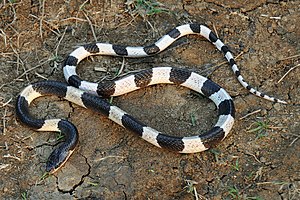Blue krait
| Blue krait | ||||||||||||
|---|---|---|---|---|---|---|---|---|---|---|---|---|

Blue krait ( Bungarus candidus ) |
||||||||||||
| Systematics | ||||||||||||
|
||||||||||||
| Scientific name | ||||||||||||
| Bungarus candidus | ||||||||||||
| ( Linnaeus , 1758) |
The Blue Krait ( bungarus candidus ) is a poisonous snake and counts within the family of poisonous snakes to the genus Kraits . The species was already described in 1758 by the founder of the classification system Carl von Linné .
Distribution area
The distribution area of the Blue Krait extends over Thailand , Cambodia, Laos, Vietnam, the Malay Peninsula , Singapore, Sumatra , Java and Bali .
features
The blue krait can reach a total length of 1.60 meters, with males becoming larger than females. The body is less triangular in cross-section than other Bungarus species. On the back there are 15, rarely 17 rows of scales, the number of ventral scales is 194 to 237, that of the subcaudalia , which is always undivided, from 37 to 56. The anal scales are also undivided. There is a pre- ocular in front of the eye, and two post-ocularia behind it. Along the upper edge of the mouth opening are seven shields of the upper lip , with the third and fourth touching the eye and the fifth and sixth being the largest.
The back and the sides of the body are patterned with 27 to 35 wide black or dark brown ribbons, the ones in front being the widest and the ribbons narrowing towards the tail. In between the snakes are whitish or pale yellowish. In older specimens, these areas are patterned with dark dots. The ventral side is also whitish or cream-colored. The top of the head is black or dark brown, the shields of the upper lip are whitish. Young animals have a white neck, but are otherwise as colored as adult specimens.
Like all Venomari has Bungarus candidus to venom glands reformed salivary glands , which via a channel with poison in the front upper jaw located, non-movable fangs are connected (proteroglyphe tooth position).
The blue krait can easily be confused with the similarly colored young animals of the non-toxic banded wolf snake ( Lycodon subcinctus ). However, these can also have a light top of the head, while the blue krait is always dark.
Habitat and way of life
The blue krait lives mainly in the lowlands, less often in the mountains up to an altitude of 1200 meters. Mostly the snake occurs near water or in other humid areas such as rice fields. It can also be found near villages or towns. The species avoids sunlight and tries to escape into the dark when exposed to it. It feeds mainly on snakes (ophiophagy). a. Skinks eaten. The females lay four to ten eggs per clutch. The newly hatched young snakes have a length of 27 to 28.5 cm.
Individual evidence
- ↑ Trutnau: Schlangen im Terrarium, Vol. 2, poisonous snakes , E. Ulmer Verlag, 1998.
literature
- Ulrich Manthey, Wolfgang Grossmann: Amphibians & Reptiles of Southeast Asia. Natur und Tier Verlag (1997), ISBN 978-3931587123 , pages 416-417.
Web links
- Bungarus candidus in The Reptile Database
- IUCN Red List: Bungarus candidus (accessed September 23, 2016)